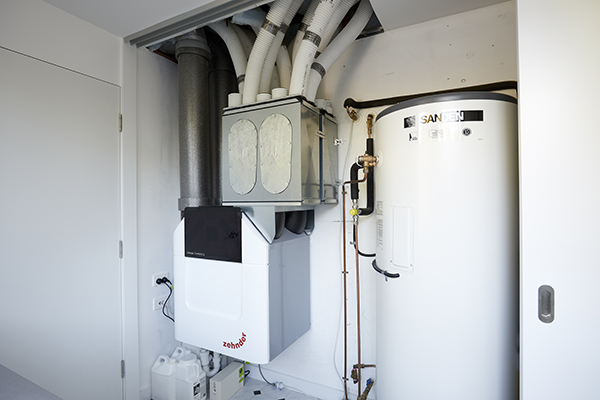Exploring HRV: A Beginner’s Guide
The All-Inclusive Guide to the Uses of Heat Recovery Ventilation in Modern Buildings
Heat Recovery Ventilation (HRV) systems stand for a substantial development in building innovation (HRV Heat Recovery Ventilation). They supply an approach for exchanging stale indoor air with fresh outside air while reducing energy loss. This technique not only improves interior air quality however also adds to power efficiency in both residential and industrial buildings. Comprehending the different applications and benefits of HRV can reveal its crucial duty in modern-day layout and sustainability initiatives. The implications of this modern technology deserve exploring even more
Understanding Heat Recovery Ventilation Solutions

Numerous contemporary buildings focus on power performance, comprehending heat recovery air flow (HRV) systems is important for maximizing interior air top quality and minimizing energy intake. HRV systems function by moving warmth from stagnant indoor air to incoming fresh air, successfully maintaining comfy interior temperature levels while lessening power loss. These systems include a warmth exchanger, fans, and ductwork that promote the circulation of air. Throughout winter months, HRV systems capture and recycle heat from the outbound air, while in summertime, they can aid cool down incoming air. By continuously exchanging air, HRV systems also minimize humidity and the concentration of indoor pollutants. Proper installation and maintenance of HRV systems are crucial for their effectiveness and effectiveness in boosting general structure efficiency and comfort.
Advantages of Heat Recovery Ventilation
Heat recovery ventilation systems offer various advantages that boost both power efficiency and interior air quality in contemporary buildings. By catching and recycling power from exhaust air, these systems substantially minimize cooling and heating expenses, causing lower energy usage. Additionally, they maintain a constant circulation of fresh outdoor air, reducing the danger of interior air contaminants and irritants. This continuous exchange aids manage humidity degrees, avoiding mold and mildew growth and making sure a healthier living setting. Furthermore, HRV systems add to sustainability goals by decreasing overall carbon footprints. Their ability to maximize ventilation without giving up thermal convenience makes them a useful enhancement to modern structure layout, advertising both economic and eco-friendly benefits.
Applications of HRV in Residential Structures
As homeowners increasingly focus on power performance and indoor air quality, the applications of warmth recuperation ventilation (HRV) systems in property structures have become more common. HRV systems are especially useful in firmly secured homes, where maintaining fresh air flow is crucial for preventing dampness buildup and interior toxins. They properly transfer warmth from outward bound stale air to inbound fresh air, lowering power costs related to cooling and heating. try this out In addition, HRVs can boost comfort degrees by regulating moisture and temperature level. They are additionally versatile for different domestic layouts, consisting of single-family homes and multi-unit structures. On the whole, integrating HRV systems supports lasting living techniques while making certain a healthier interior setting for owners.
HRV in Business and Commercial Settings
In business and commercial setups, the implementation of heat recovery ventilation (HRV) systems has actually ended up being significantly essential for maximizing power performance and keeping air high quality. These systems successfully transfer warm from exhaust air to incoming fresh air, decreasing the demand for extra home heating or cooling. This not only reduces power expenses however likewise contributes to sustainability efforts. Industries such as production, warehousing, and office complex benefit substantially from HRV systems, as they aid manage temperature and humidity levels, making certain a comfy and effective atmosphere. HRV systems aid in removing contaminants and excess dampness, enhancing interior air top quality. As policies around air high quality end up being stricter, the fostering of HRV technology is likely to expand, making it an essential element of contemporary business and industrial framework.
Future Trends in Heat Recovery Ventilation Innovation

Frequently Asked Questions
Exactly How Does Heat Recovery Ventilation Influence Indoor Air Quality?
Heat recovery ventilation significantly enhances interior air high quality by continuously trading stale interior air with fresh exterior air while recuperating energy. This process lowers contaminants, keeps optimal moisture levels, and ensures a much healthier setting for occupants.
Can HRV Systems Be Installed in Existing Structures?
HRV systems can undoubtedly be set up in existing buildings. Retrofitting may require modifications to ductwork and ventilation formats, but it significantly improves energy performance and interior air quality, making it a viable choice for older frameworks.
What Maintenance Is Needed for HRV Equipments?

Exist Details Climates Where HRV Is Much More Effective?
Heat recovery ventilation systems are particularly reliable in climates with considerable temperature level distinctions between seasons. These systems maximize power effectiveness by recuperating warmth from exhaust air, making them optimal for both chilly and reasonably cozy settings.
How Do HRV Solutions Affect Power Bills?
